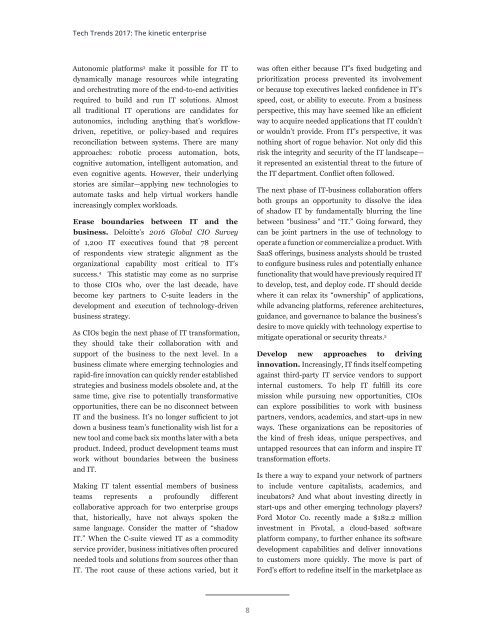Trending the trends Eight years of research
2kcf8xh
2kcf8xh
You also want an ePaper? Increase the reach of your titles
YUMPU automatically turns print PDFs into web optimized ePapers that Google loves.
Tech Trends 2017: The kinetic enterprise<br />
Autonomic platforms 3 make it possible for IT to<br />
dynamically manage resources while integrating<br />
and orchestrating more <strong>of</strong> <strong>the</strong> end-to-end activities<br />
required to build and run IT solutions. Almost<br />
all traditional IT operations are candidates for<br />
autonomics, including anything that’s workflowdriven,<br />
repetitive, or policy-based and requires<br />
reconciliation between systems. There are many<br />
approaches: robotic process automation, bots,<br />
cognitive automation, intelligent automation, and<br />
even cognitive agents. However, <strong>the</strong>ir underlying<br />
stories are similar—applying new technologies to<br />
automate tasks and help virtual workers handle<br />
increasingly complex workloads.<br />
Erase boundaries between IT and <strong>the</strong><br />
business. Deloitte’s 2016 Global CIO Survey<br />
<strong>of</strong> 1,200 IT executives found that 78 percent<br />
<strong>of</strong> respondents view strategic alignment as <strong>the</strong><br />
organizational capability most critical to IT’s<br />
success. 4 This statistic may come as no surprise<br />
to those CIOs who, over <strong>the</strong> last decade, have<br />
become key partners to C-suite leaders in <strong>the</strong><br />
development and execution <strong>of</strong> technology-driven<br />
business strategy.<br />
As CIOs begin <strong>the</strong> next phase <strong>of</strong> IT transformation,<br />
<strong>the</strong>y should take <strong>the</strong>ir collaboration with and<br />
support <strong>of</strong> <strong>the</strong> business to <strong>the</strong> next level. In a<br />
business climate where emerging technologies and<br />
rapid-fire innovation can quickly render established<br />
strategies and business models obsolete and, at <strong>the</strong><br />
same time, give rise to potentially transformative<br />
opportunities, <strong>the</strong>re can be no disconnect between<br />
IT and <strong>the</strong> business. It’s no longer sufficient to jot<br />
down a business team’s functionality wish list for a<br />
new tool and come back six months later with a beta<br />
product. Indeed, product development teams must<br />
work without boundaries between <strong>the</strong> business<br />
and IT.<br />
Making IT talent essential members <strong>of</strong> business<br />
teams represents a pr<strong>of</strong>oundly different<br />
collaborative approach for two enterprise groups<br />
that, historically, have not always spoken <strong>the</strong><br />
same language. Consider <strong>the</strong> matter <strong>of</strong> “shadow<br />
IT.” When <strong>the</strong> C-suite viewed IT as a commodity<br />
service provider, business initiatives <strong>of</strong>ten procured<br />
needed tools and solutions from sources o<strong>the</strong>r than<br />
IT. The root cause <strong>of</strong> <strong>the</strong>se actions varied, but it<br />
was <strong>of</strong>ten ei<strong>the</strong>r because IT’s fixed budgeting and<br />
prioritization process prevented its involvement<br />
or because top executives lacked confidence in IT’s<br />
speed, cost, or ability to execute. From a business<br />
perspective, this may have seemed like an efficient<br />
way to acquire needed applications that IT couldn’t<br />
or wouldn’t provide. From IT’s perspective, it was<br />
nothing short <strong>of</strong> rogue behavior. Not only did this<br />
risk <strong>the</strong> integrity and security <strong>of</strong> <strong>the</strong> IT landscape—<br />
it represented an existential threat to <strong>the</strong> future <strong>of</strong><br />
<strong>the</strong> IT department. Conflict <strong>of</strong>ten followed.<br />
The next phase <strong>of</strong> IT-business collaboration <strong>of</strong>fers<br />
both groups an opportunity to dissolve <strong>the</strong> idea<br />
<strong>of</strong> shadow IT by fundamentally blurring <strong>the</strong> line<br />
between “business” and “IT.” Going forward, <strong>the</strong>y<br />
can be joint partners in <strong>the</strong> use <strong>of</strong> technology to<br />
operate a function or commercialize a product. With<br />
SaaS <strong>of</strong>ferings, business analysts should be trusted<br />
to configure business rules and potentially enhance<br />
functionality that would have previously required IT<br />
to develop, test, and deploy code. IT should decide<br />
where it can relax its “ownership” <strong>of</strong> applications,<br />
while advancing platforms, reference architectures,<br />
guidance, and governance to balance <strong>the</strong> business’s<br />
desire to move quickly with technology expertise to<br />
mitigate operational or security threats. 5<br />
Develop new approaches to driving<br />
innovation. Increasingly, IT finds itself competing<br />
against third-party IT service vendors to support<br />
internal customers. To help IT fulfill its core<br />
mission while pursuing new opportunities, CIOs<br />
can explore possibilities to work with business<br />
partners, vendors, academics, and start-ups in new<br />
ways. These organizations can be repositories <strong>of</strong><br />
<strong>the</strong> kind <strong>of</strong> fresh ideas, unique perspectives, and<br />
untapped resources that can inform and inspire IT<br />
transformation efforts.<br />
Is <strong>the</strong>re a way to expand your network <strong>of</strong> partners<br />
to include venture capitalists, academics, and<br />
incubators? And what about investing directly in<br />
start-ups and o<strong>the</strong>r emerging technology players?<br />
Ford Motor Co. recently made a $182.2 million<br />
investment in Pivotal, a cloud-based s<strong>of</strong>tware<br />
platform company, to fur<strong>the</strong>r enhance its s<strong>of</strong>tware<br />
development capabilities and deliver innovations<br />
to customers more quickly. The move is part <strong>of</strong><br />
Ford’s effort to redefine itself in <strong>the</strong> marketplace as<br />
8


